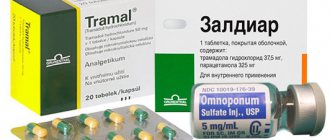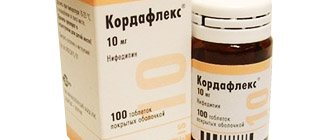Indapamide
special instructions
If liver function is impaired, thiazide and thiazide-like diuretics can lead to the development of hepatic encephalopathy. In this case, the use of diuretics must be stopped immediately.
Cases of photosensitivity reactions have been reported when taking thiazide and thiazide-like diuretics. If photosensitivity reactions develop during therapy, you should immediately stop taking indapamide. If it is necessary to continue diuretic therapy, it is recommended to protect the skin from exposure to sunlight or artificial ultraviolet rays.
The concentration of sodium ions in the blood plasma must be determined before starting treatment and then regularly monitor this indicator. Hyponatremia and hypovolemia can lead to dehydration and orthostatic hypotension. A concomitant decrease in the concentration of chloride ions can lead to secondary metabolic alkalosis. For patients with liver cirrhosis and elderly patients, more frequent monitoring of the concentration of sodium ions in the blood plasma is indicated.
Long-term use of thiazide and thiazide-like diuretics poses a risk of decreasing plasma potassium concentrations and developing hypokalemia. It is necessary to prevent the risk of developing hypokalemia (<3.4 mmol/l), especially in elderly patients, debilitated or receiving concomitant drug therapy, in patients with liver cirrhosis accompanied by edema and ascites, in patients with coronary vascular diseases and heart failure, since hypokalemia entails the likelihood of arrhythmia (hypokalemia in patients of these groups enhances the toxic effect of cardiac glycosides). The risk of hypokalemia is also possible in patients with a prolonged QT interval. Hypokalemia predisposes to the occurrence of severe arrhythmias, especially the deadly polymorphic ventricular tachycardia of the “pirouette” type. It is necessary to regularly monitor the potassium content in the blood plasma in all of the above cases.
Thiazide and thiazide-like diuretics may reduce the excretion of calcium ions by the kidneys, which may lead to a moderate and temporary increase in plasma calcium concentrations.
It is necessary to regularly monitor the concentration of glucose in the blood plasma in patients with diabetes mellitus, especially in the presence of hypokalemia.
If the concentration of uric acid is elevated, attacks of gout may occur; in such cases, it is necessary to adjust the dose of indapamide accordingly.
Hypovolemia caused by loss of fluid and sodium ions, when treated with diuretics, can cause a decrease in glomerular filtration, which may result in an increase in the concentrations of urea and creatinine in the blood plasma.
Impact on the ability to drive vehicles and machinery
During the treatment period, patients who experience dizziness, fatigue, headache, or decreased blood pressure should refrain from driving vehicles and other activities that require high concentration and speed of psychomotor reactions.
Indapamide, 1.5 mg, extended-release film-coated tablets, 30 pcs.
Not recommended combinations: when used simultaneously with lithium preparations, it is possible to increase the concentration of lithium ions in the blood plasma due to a decrease in its excretion from the body by the kidneys, accompanied by the appearance of signs of overdose (nephrotoxic effect), as well as when following a salt-free diet (reduced excretion of lithium ions by the kidneys) .
Combinations requiring special attention:
1) Drugs that can cause heart rhythm disturbances of the “pirouette” type: class IA antiarrhythmics (quinidine, hydroquinidine, disopyramide), class III antiarrhythmics (amiodarone, dofetilide, ibutilide, bretylium tosylate), sotalol, some neuroleptics: phenothiazines (chlorpromazine , cyamemazine, levomepromazine, thioridazine, trifluoperazine), benzamides (amisulpride, sulpiride, sultopride, tiapride), butyrophenones (droperidol, haloperidol), others (bepridil, cisapride, difemanil, erythromycin (intravenous (IV)), halofantrine, mizolastine , pentamidine, sparfloxacin, moxifloxacin, vincamine (iv), astemizole. Concomitant use with any of these drugs, especially against the background of hypokalemia, increases the risk of ventricular arrhythmias. Before starting combination therapy with indapamide and the above drugs, potassium levels should be monitored blood plasma and, if necessary, adjust it.
Recommended: monitoring the patient’s clinical condition, as well as the content of electrolytes in the blood plasma and ECG. In patients with hypokalemia, it is necessary to use drugs that do not provoke the development of arrhythmias.
2) With the simultaneous use of non-steroidal anti-inflammatory drugs (NSAIDs) (for systemic use), including selective inhibitors of cyclooxygenase-2 (COX-2), high doses of salicylic acid (3 g / day or more), it is possible: a decrease in the antihypertensive effect of indapamide, the development of acute renal failure in dehydrated patients (due to decreased glomerular filtration rate). At the beginning of indapamide therapy, it is necessary to restore water and electrolyte balance and monitor renal function.
3) Angiotensin-converting enzyme (ACE) inhibitors in patients with hyponatremia (especially in patients with renal artery stenosis) increase the risk of developing arterial hypotension and/or acute renal failure. Patients with arterial hypertension and possibly hyponatremia due to taking diuretics should: - stop taking the drug 3 days before starting therapy with ACE inhibitors and switch to therapy with potassium-sparing diuretics; - or start therapy with ACE inhibitors with low doses, followed by a gradual increase in dose if necessary. During the first week of therapy with ACE inhibitors, it is recommended to monitor plasma creatinine concentrations.
4) Other drugs that can cause hypokalemia: amphotericin B (iv), gluco- and mineralocorticosteroids (if administered systemically) (see also information in the section “Drug combinations requiring attention”), tetracosactide (see also information in the section “Drug combinations that require attention”), laxatives that stimulate intestinal motility. When taken simultaneously with indapamide, the above drugs increase the risk of developing hypokalemia (additive effect). If necessary, the content of potassium ions in the blood plasma should be monitored and adjusted.
5) Simultaneous therapy with baclofen enhances the antihypertensive effect of indapamide.
6) Cardiac glycosides: hypokalemia increases the toxic effect of cardiac glycosides (glycoside intoxication). With the simultaneous use of indapamide and cardiac glycosides, the content of potassium ions in the blood plasma, ECG parameters should be monitored, and, if necessary, therapy should be adjusted.
Combinations of drugs requiring attention:
1) Simultaneous use with potassium-sparing diuretics (amiloride, spironolactone, triamterene) is advisable in some patients, but the possibility of developing hypokalemia cannot be excluded. Hyperkalemia may develop against the background of diabetes mellitus or renal failure. It is necessary to monitor the content of potassium ions in the blood plasma, ECG indicators, and, if necessary, adjust therapy.
2) Metformin increases the risk of developing lactic acidosis, since renal failure may develop while taking diuretics, especially loop diuretics. Metformin should not be taken if the plasma creatinine concentration is more than 15 mg/l (135 µmol/l) in men and 12 mg/l (110 µmol/l) in women.
3) Simultaneous use of large doses of iodine-containing contrast agents against the background of hypovolemia and diuretics increases the risk of developing acute renal failure. It is recommended to restore the water and electrolyte balance of the blood before using the drugs.
4) Tricyclic antidepressants (imipramine-like) and antipsychotics increase the antihypertensive effect and the risk of developing orthostatic hypotension (additive effect).
5) Preparations containing calcium salts increase the risk of developing hypercalcemia due to a decrease in the excretion of calcium ions by the kidneys.
6) Cyclosporine, tacrolimus - the risk of increasing the concentration of creatinine in the blood plasma without changing the concentration of circulating cyclosporine.
7) Glucocorticosteroid drugs, tetracosactide (when used systemically) reduce the antihypertensive effect (retention of sodium ions and fluid).
Instructions for use INDAPAMIDE PHARMLAND
In patients with hepatic impairment, thiazide-like diuretics may accelerate the development of hepatic encephalopathy. If symptoms of hepatic encephalopathy occur, indapamide should be discontinued immediately.
Water and electrolyte balance
Plasma sodium level:
Before starting treatment with the drug, and then regularly it is necessary to monitor the concentration of sodium in the serum. Any diuretic treatment can lead to low sodium levels with very serious consequences. A decrease in plasma sodium may initially be asymptomatic, so regular monitoring of sodium levels is required. In elderly people or in patients with cirrhosis of the liver, these studies should be performed more often.
Plasma potassium content:
Serum potassium should be monitored regularly during treatment. A decrease in potassium levels with possible subsequent hypokalemia is the main risk of taking thiazide and other diuretics based on it. Prevention of the risk of hypokalemia (<3.4 mmol/L) should be carried out in certain high-risk populations, for example, the elderly, people who are malnourished and/or taking multiple medications at the same time, cirrhotic patients with edema and ascites, patients with coronary vascular disease and hearts. In this situation, hypokalemia increases the cardiac toxicity of digitalis drugs and the risk of arrhythmias. Patients with a prolonged QT interval are also at risk, regardless of whether it is congenital or iatrogenic. Hypokalemia, as well as bradycardia, are a predisposing factor for the occurrence of severe arrhythmias, in particular the potentially fatal atrial flutter-fibrillation. In all of the above situations, more frequent monitoring of plasma potassium levels is necessary. The first measurement of plasma potassium should be performed in the first week of starting treatment. In case of hypokalemia, potassium deficiency should be compensated.
Plasma calcium content:
Thiazide and thiazide-like diuretics may reduce urinary calcium excretion, causing mild transient hypercalcemia. Severe hypercalcemia may result from unrecognized hyperparathyroidism. In this case, it is necessary to interrupt treatment and examine the patient for the function of the parathyroid glands.
Blood sugar level
In patients with diabetes mellitus, especially those with concomitant hypokalemia, it is necessary to monitor blood glucose levels.
Uric acid
Patients with hyperuricemia tend to have an increased frequency of gout attacks. If uric acid levels increase, dose adjustment is necessary.
Kidney function and diuretics
Thiazides and thiazide-like diuretic drugs are fully effective only in the case of normal renal function or only mild impairment (creatinine content below 25 mg/l, i.e. 220 mmol/l). Hypovolemia associated with fluid loss, which may occur at the beginning of diuretic treatment, leads to a decrease in glomerular filtration, which in turn causes an increase in serum urea and creatinine concentrations. Such transient functional renal failure passes without consequences in patients with normal renal function, but at the same time it can aggravate existing renal failure.
Athletes
The drug may cause false-positive anti-doping test results in athletes.
Impact on the ability to drive vehicles and machinery
While taking Indapamide Pharmland, especially at the beginning of treatment or when prescribing another antihypertensive drug for combination treatment, symptoms associated with a drop in blood pressure may occur. In such a situation, the ability to drive vehicles and maintain machinery may be impaired.

